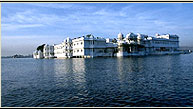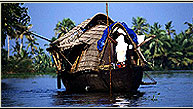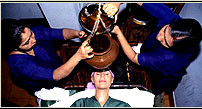Buddhist Sites
-| Dhamnar | -
Location: District Mandsor (M.P.) - Lat 24º 12'N, Long 75º
30 E
The site is situated on the flat topped Laterite hill of Dhamnar, about 20 kms.
west of the Shamgarh railway station.
There are nearly fifty caves which are fully exposed.These caves are generally
located on the precipitous faces near the top. They are connected in many places
with the courts in front of the caves by means of rock -cut stairs. These Buddhist
caves are noted more for the striking peculiarity of the layout than sculptural
embellishment. The images of Lord Buddha were fashioned on rough pillared surface
of the rock, but there is a distinct predilection towards stupas. A number of
these stupas are freely standing in the open, as objects of worship within sanctuaries
and as reliefs within niches are numerous. These stupa have a well -developed
form. The stupas as well as the relieved images can be dated between 4th &
6th century A.D. There are few caves which are notable for Chaitya Griha.
The cave 14, having an oblong court, is fairly large rock cut stupa. In the
sanctuary, there is a colossal image of Lord Buddha, seated in a Vajra Paryankana
on a cushion supported by lions carved against the back wall. The cave 13 is
a chaitya griha with a court in front. Enter through a single colossal door,
the chaitya griha is divided into an oblong flat roofed nave and ape by two
pilasters with their inner sides arched. The shape of the highly elongated stupa
has a tapering drum over the octagonal base and is capped by a set of moulding
and the dome that present the shape of the three fourth of an egg. The layout
of cave 12 is interesting. It consists of a flat roofed free -standing apsidal
chaitya griha roughly occupying the centre of the oblong court. Beyond this
chaitya griha, on three sides are pillared veranda with ranges of cells, not
of uniform dimension. In the front of this cave, there are a few small free
standing stupas.
The cave 11 consists of a pillared Veranda and a hall at the back. These pillars,
as well as those of the veranda, have moulded bases, oblong tapering shafts
and usual rolled up bracket capitals. Cave 9 is a chaitya griha oblong on plan,
the flat eaves in the front of the veranda are supported by two pilasters with
moulded bases and bracket capitals at either end. The cave 7 is an elaborate
cave and consists of a veranda similar to that of cave 11. This veranda can
be approached from the court by a staircase with a cell at its dexture end.
A pillared hall with images of cells on three sides, the central cell of back
side being a sanctuary with a stupa as the object of worship.
Other caves are of little significance. They generally are comprised of a veranda,
often open and sometimes closed, with one or more cells, some of the cells have
recess with rock cut beds and pillars. There are many free standing rock cut
stupas, often in group.
The whole site has a beautiful natural setting and provides a panoramic view
from hill top.
Dhamnar
- Buddhist, Archaeology in India
Reservation Form
 Special
Indian Tour packages Special
Indian Tour packages |



